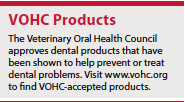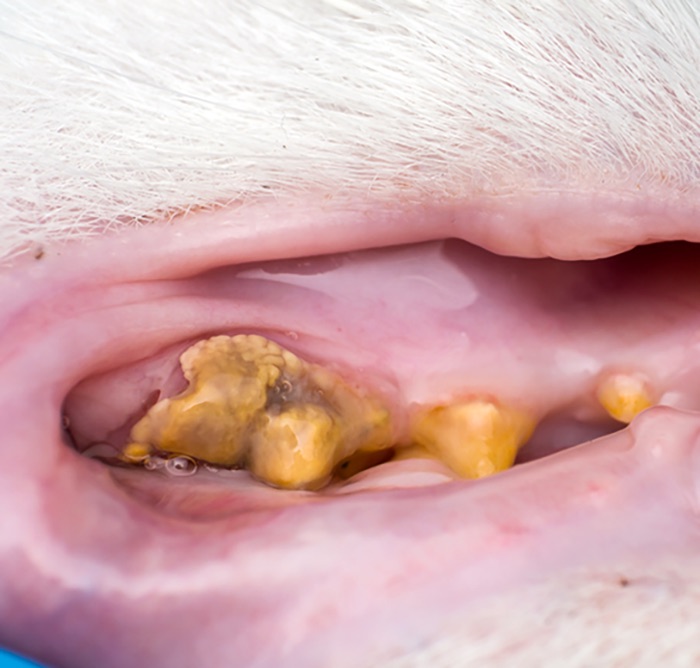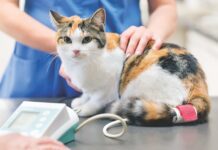Between 50% and 90% of cats over 4 years of age have dental disease. And, just like you, bad teeth make it difficult for your cat to eat and drink and can leave her feeling lousy. If you haven’t done it already, schedule a dental exam for your senior kitty today.
Symptoms
Signs of a dental problem include drooling, pawing at the mouth, bad breath, and decreased or lack of appetite. Some cats with painful dental conditions approach their food bowl eagerly, but then walk away.
More subtle signals can be weight loss and a failure to groom normally. Of course, many of these signs may be associated with other senior-cat problems such as kidney failure, arthritis, and some cancers, which is just another reason senior-cat veterinary appointments are so important.
Examination
At the veterinary clinic, your veterinarian will examine your cat’s mouth for tartar, plaque, gingivitis (inflammation of the gums), and periodontitis (inflammation of the tissues around the teeth themselves, including bones). Left untreated, these problems can lead to potentially life-threatening diseases.
Uncooperative cats and cats that need dental radiographs (x-rays) will require sedation or general anesthesia for a thorough exam. Your veterinarian may choose to do these all at once, with a scheduled dental cleaning and extraction of problem teeth.
In the pre-operative phase, your veterinarian will usually screen for common senior-cat health problems using bloodwork, measurement of blood pressure, and perhaps an echocardiogram if he/she hears a heart murmur during a physical examination. If your cat has chronic health problems, your veterinarian will likely recommend that these problems are brought under control first. Once these conditions are stable, your cat’s anesthetic risks usually decrease dramatically.
“Dental cleanings and procedures are done under full anesthesia and are generally considered an elective procedure, meaning there is no medical urgency to have them performed in a particular time frame. So, if the patient has underlying systemic disease or cancer, then we may not recommend an elective procedure,” says Sydney L. Warshaw, VMD, dentistry and oral surgery resident at Cornell University’s College of Veterinary Medicine.
“As long as the pet is healthy and can be safely placed under general anesthesia, then we do recommend routine professional dental cleanings and comprehensive oral assessments/diagnostics. The frequency of these exams varies per individual and will depend on what disease may be found, its severity, and how the clinician and owner have decided to treat it,” says Dr. Warshaw.
Extractions are not uncommon. While having a toothless, or nearly toothless, cat may seem a shock, realize that once your cat’s mouth has healed from the extractions, she will usually be able to eat and drink without pain.
Post Surgery
After a dental procedure, your cat will need some extra care while her mouth heals. She may prefer both her food and water at room temperature. Food should be canned, if possible, and made into a slurry for easy consumption. Kibble can be softened. Your veterinarian may suggest subcutaneous fluids, which you can learn to administer at home, to keep her normally hydrated by adding water.
Once her mouth is healed, the goal is to keep her teeth in the best condition possible. Luckily, most senior cats accept dental procedures well, all things considered. Some older cats even come to enjoy—OK, maybe tolerate is a better word—dental care at home (see VOHC sidebar). Brushing is the gold standard for dental care, even with missing teeth.
 If she is not used to her teeth being brushed, start by simply letting her lick a feline-approved toothpaste from your finger (not human toothpaste, which can be toxic to cats). Eventually, you can move to a toothbrush or finger brush, which many cats prefer. If your cat is toothless or nearly so, you can simply stick to your finger and apply a dental gel.
If she is not used to her teeth being brushed, start by simply letting her lick a feline-approved toothpaste from your finger (not human toothpaste, which can be toxic to cats). Eventually, you can move to a toothbrush or finger brush, which many cats prefer. If your cat is toothless or nearly so, you can simply stick to your finger and apply a dental gel.
“We recommend starting slow,” says Dr. Warshaw. “Start small and work your way up to brushing. This is a process that can take weeks! First, get the cat used to having their mouth manipulated, such as by raising their lips to show their teeth, then immediately reward them with play or a treat. When that cat is comfortable with having the owner expose their teeth, then use your finger or a very soft bristled toothbrush to gently touch the surface of the teeth, always following with a reward. Once they are comfortable with the toothbrush against their teeth, then you can add on a feline toothpaste, which many times acts as its own reward or treat.”

Visit Cornell University College of Veterinary Medicine’s website at: https://partnersah.vet.cornell.edu/pet-owners/cat-teeth to view videos on how to train your cat to accept her teeth being brushed.




